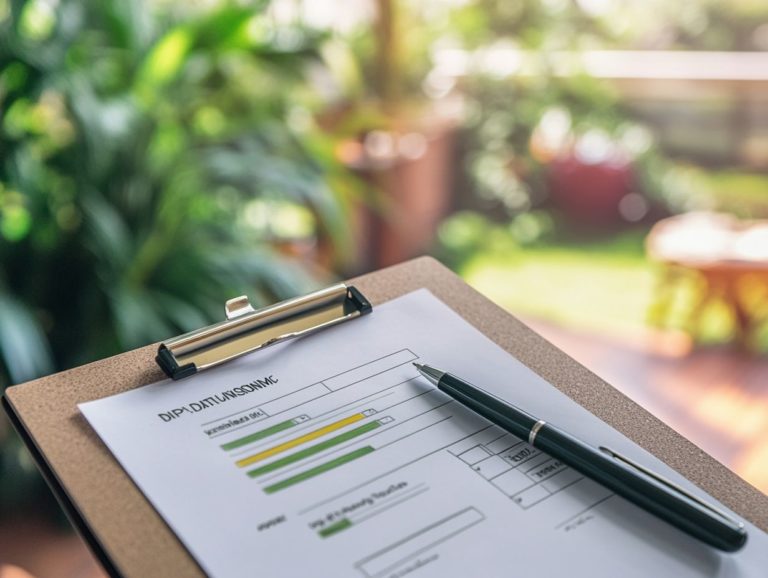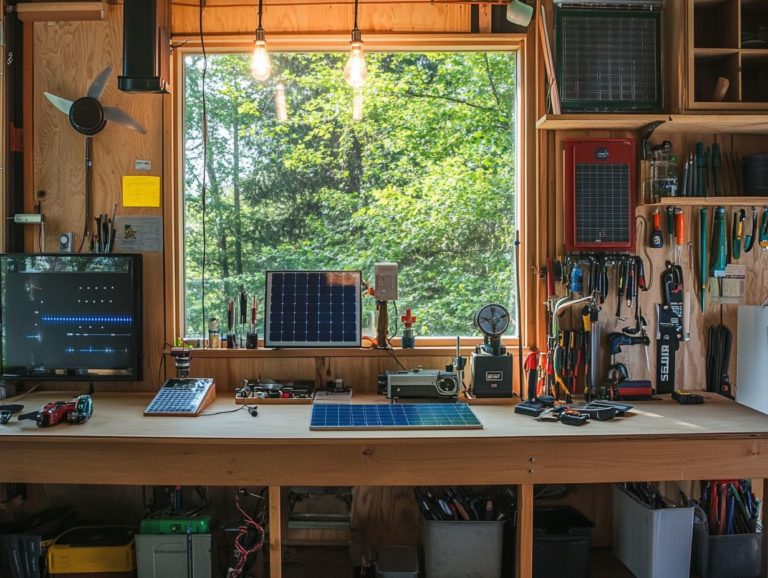How to Build Your Own Solar-Powered Battery Charger
As the world increasingly embraces sustainable energy solutions, solar-powered battery chargers stand out as an exquisite eco-friendly option for keeping your devices charged.
Consider the prospect of harnessing the sun’s energy to power your gadgets while saving money a truly rewarding endeavor, especially in regions like the Midwest and Mid-Atlantic. This article will guide you through the many benefits of constructing your own charger, outline the materials you’ll require, and provide a comprehensive, step-by-step process for creating a solar-powered device.
You will also find valuable troubleshooting tips and insights into alternative energy sources, including wind and hydro power, ensuring you are fully prepared to harness the advantages of renewable energy.
Get ready to unlock the amazing power of solar energy and enjoy the benefits!
Contents
- Key Takeaways:
- Benefits of Building Your Own Charger
- Materials Needed
- Step-by-Step Guide to Building a Solar-Powered Battery Charger
- Troubleshooting and Maintenance
- Alternative Energy Sources for Charging Batteries
- Frequently Asked Questions
- What materials do I need to build my own solar-powered battery charger?
- Do I need any special skills or knowledge to build a solar-powered battery charger?
- How long does it take to build a solar-powered battery charger?
- Can I use any type of solar panel to build a solar-powered battery charger?
- How much power can I generate with a solar-powered battery charger?
- Can I build a solar-powered battery charger for different types of batteries?
Key Takeaways:

- Save money and customize your charging experience by building your own solar-powered battery charger.
- All you need are a few materials, including a solar panel and a blocking diode, and our step-by-step guide to get started on your eco-friendly charging solution.
- Consider alternative energy sources like wind or hydro power for charging batteries. Solar kits may also be a better fit for your location and needs.
What are Solar-Powered Battery Chargers?
Solar-powered battery chargers are remarkable devices that capture the sun’s energy to recharge batteries, serving as an eco-friendly alternative to traditional chargers. By harnessing solar panels, you can convert sunlight into electricity through the photovoltaic effect (the process of converting sunlight into electricity), allowing you to power various rechargeable batteries from smartphones to flashlights and beyond.
As solar technology continues to gain traction, more individuals are discovering the advantages of building their own solar-powered battery chargers. Additionally, many are interested in how to build your own solar water heater, which is perfect for outdoor adventures or as a reliable backup power source for home or industrial solar use.
These chargers generally comprise solar panels, a charge controller, a battery storage unit, and a selection of connectors for different devices. The solar panels diligently collect sunlight and convert it into direct current (DC) electricity. The charge controller ensures that the voltage is regulated, charging the battery safely and efficiently. Some advanced designs even incorporate a step-up inverter to handle devices requiring higher voltage.
The versatility of solar-powered battery chargers is impressive, able to charge everything from small personal devices like MP3 players to larger setups capable of charging car batteries or even powering small appliances in off-grid scenarios.
As innovative designs continue to emerge, you ll find that these solutions not only help reduce energy costs but also contribute to a sustainable, energy-efficient lifestyle.
Benefits of Building Your Own Charger
Building your own solar-powered battery charger presents a wealth of benefits that you won t want to overlook. Imagine the cost savings you ll enjoy, along with the freedom to customize your charger to fit your unique needs.
By crafting a charger specifically designed for your requirements, you can not only save money compared to off-the-shelf options but also ensure it effectively charges a variety of rechargeable batteries like NiMh and lithium-ion.
Furthermore, embarking on this project allows you to harness eco-friendly energy sources, minimizing your dependence on the power grid and promoting a more sustainable lifestyle. It s a rewarding journey that not only enriches your skill set but also aligns with a commitment to environmental responsibility. This is especially beneficial during critical periods of peak sunlight hours.
Cost Savings and Customization
Crafting your own solar-powered charger can lead to significant cost savings compared to purchasing one. With the right materials and tools, you can create a charger that meets your needs for various rechargeable batteries, like NiMh (Nickel-Metal Hydride) and lithium-ion.
The DIY route reduces your initial investment. Ready-made chargers often come with high prices for features you may not need.
Customizing your charger lets you select components designed for your devices like smartphones and tablets. This way, you can choose batteries with various capacities to enhance the longevity of your charging solution.
This hands-on project not only provides you with a functional charger but also deepens your understanding of solar technology. You will gain the skills to troubleshoot or upgrade your system whenever needed.
Materials Needed
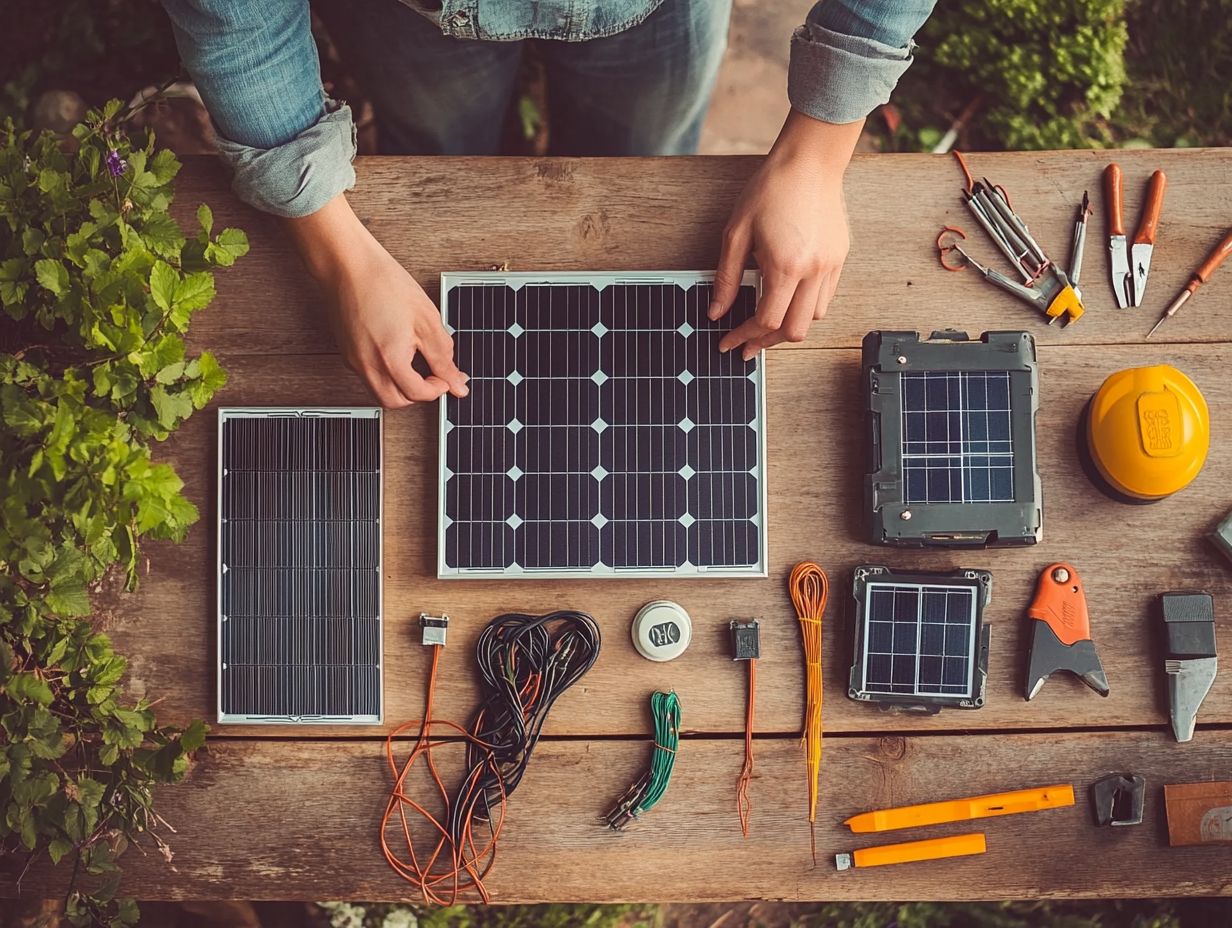
To build your own solar-powered charger, gather essential materials for an efficient system. You can find these components at local stores or online.
Key components include solar panels, which convert sunlight into electricity, and rechargeable batteries that store this energy. You ll also need a blocking diode, which stops electricity from flowing back, along with circuit tools like a soldering iron.
Gathering the right materials sets you up for success. It will also enhance the performance and lifespan of your charger.
List of Required Components
Get ready to create your very own solar-powered battery charger! You ll need a solar panel for capturing sunlight, a blocking diode (like 1N4001 or 1N914) to prevent battery discharge, and suitable rechargeable batteries such as NiMh.
Be sure to check the specifications of your solar panel to deliver at least 5 to 20 watts of power, depending on your energy needs. If you’re looking for a guide, you might want to explore how to build a solar-powered water pump. The type of rechargeable battery matters too; options like lead-acid or lithium-ion have different advantages.
Don t forget other important materials like a charge controller to regulate voltage and protect against overcharging, wiring, a battery enclosure, and a fuse. Each component is crucial for maximizing solar energy capture and extending battery life.
Step-by-Step Guide to Building a Solar-Powered Battery Charger
Embarking on the journey to create your very own solar-powered battery charger is exhilarating. It s a fulfilling way to embrace renewable energy and hone your DIY expertise.
This carefully designed step-by-step guide will lead you through the entire process. From collecting essential materials to assembling the charger and connecting components, you ll gain a solid understanding of the project. This guide will get you ready to build your very own charger!
With valuable techniques and insights woven throughout, you will discover that building your own charger is not just achievable it s a genuinely enjoyable experience.
Instructions and Tips for Assembly
Following precise instructions during the assembly of your solar-powered battery charger is essential to ensure the device operates correctly and efficiently. Begin by carefully soldering the connections between the solar panel and the circuit components. Use your soldering iron with finesse to create strong, reliable connections that can withstand outdoor conditions. Make sure to research best practices to avoid common pitfalls during the soldering process.
Pay meticulous attention to the polarity of each connection; polarity refers to the positive and negative sides of the connections. Reversing these terminals can lead to frustrating malfunctions. Secure every solder joint to prevent disconnections during use. Double-check that all wires are properly insulated to avoid the dreaded shorts which are unintended electrical connections. Using a durable container, like Tupperware, can help protect your charger and its components from environmental factors.
Should you encounter any issues, such as the charger failing to work, start troubleshooting by verifying each connection and searching for cold solder joints that may need reworking. This careful assembly process not only enhances the durability of your solar charger but also maximizes its efficiency in converting sunlight into usable energy. Regular maintenance and occasional upgrades will ensure your charger remains functional and efficient over time.
Troubleshooting and Maintenance
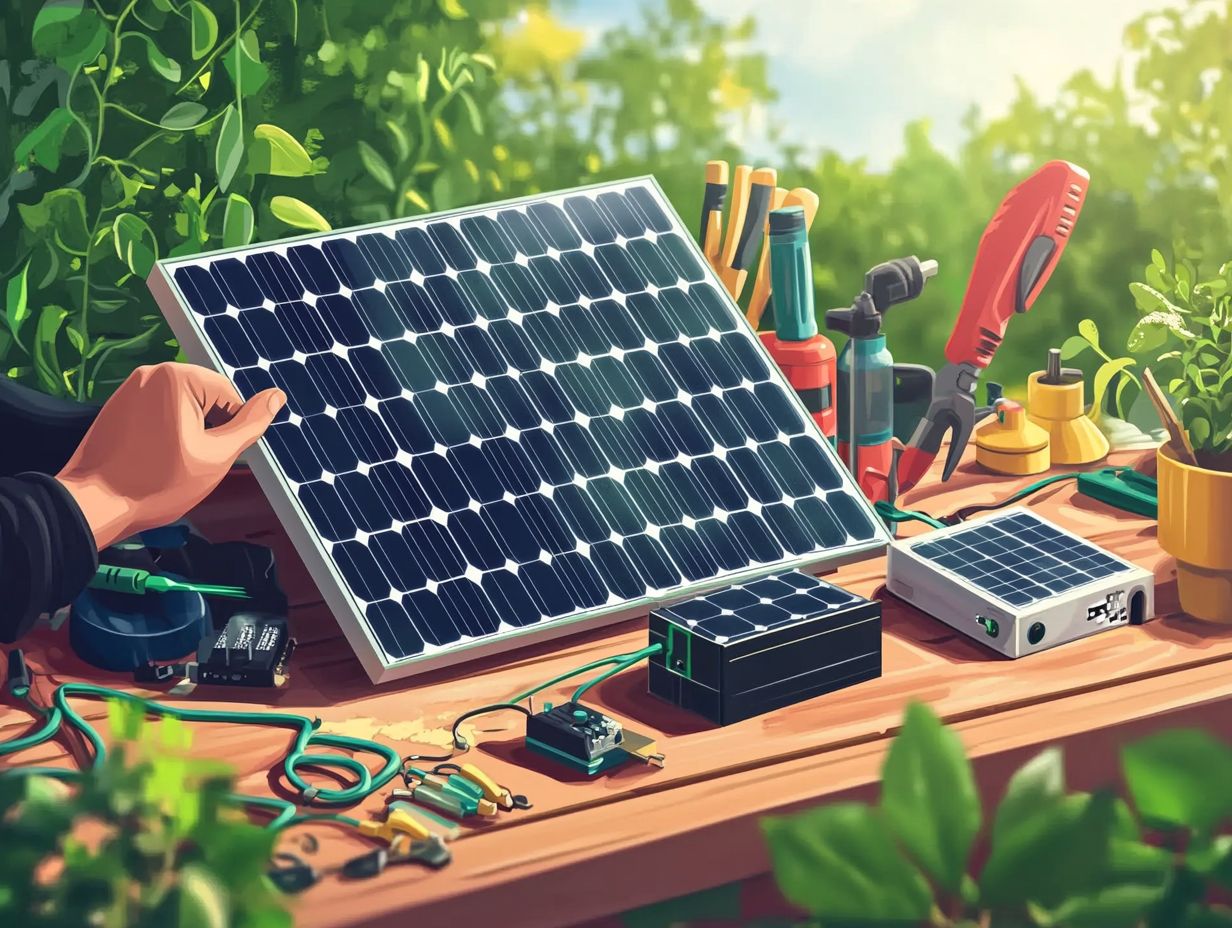
To ensure the longevity and optimal performance of your solar-powered battery charger, proper troubleshooting and maintenance are essential. Regular checks and timely replacements of components can prevent minor issues from escalating into significant problems.
Common issues include insufficient charging due to limited sunlight, circuit failures, and rechargeable batteries that don’t hold a charge. Monitor sunlight intensity and duration, especially during June, to reduce these challenges.
By understanding these challenges and equipping yourself with the knowledge to resolve them, you’ll be able to maintain an effective and reliable solar charger for your needs.
Common Issues and How to Fix Them
When using a solar-powered battery charger, you might encounter common issues like inadequate charging, overheating batteries, or component failures. To address these challenges effectively, understanding the underlying causes and implementing practical solutions is essential.
For instance, adjusting the angle of the solar panel to capture optimal sunlight, checking connections, and replacing faulty rechargeable batteries can make a significant difference. Additionally, learning how to make your own solar oven can further enhance your energy management. Understanding the characteristics of different batteries, such as NiMh and lithium-ion, can also help you manage your power storage and usage better.
Inadequate charging often results from placing the charger in shaded areas or positioning it away from direct sunlight. Regularly repositioning the solar panel, especially during peak hours, can capture more sunlight.
Overheating can become a concern if the charger is exposed to extreme temperatures. Keep it in a well-ventilated area and monitor usage times during hot weather, particularly for your DIY solar-powered projects.
Component failure typically signals wear and tear. Conducting routine inspections of your charger circuit can help catch issues before they escalate.
Lastly, regular maintenance like cleaning the solar cells and ensuring all connections are secure is crucial for maintaining efficiency and extending the lifespan of your charger.
Alternative Energy Sources for Charging Batteries
Beyond solar power, you have a wealth of alternative energy sources available for charging batteries, including wind and hydro power. Each method presents its own set of advantages and challenges, making it vital to evaluate these options carefully.
Consider factors like energy efficiency, availability, and environmental impact in your analysis. By understanding the benefits and limitations of each alternative, you can make an informed decision about the most suitable energy source for your charging needs, whether for outdoor activities or integrating into the power grid.
Comparing Solar, Wind, and Hydro Power
When considering solar, wind, and hydro power as alternatives for charging your batteries, you should focus on a few key factors: energy efficiency, installation costs, and environmental impact.
Solar power is remarkably accessible and demands minimal maintenance, making it a go-to option for many solar-powered electronics projects. Wind power, however, boasts impressive energy generation potential in areas where the winds are favorable.
Hydro power can deliver a reliable energy supply but is often more complex to set up. These renewable sources shine not only in their energy output but also in their effectiveness for battery charging.
You can strategically position solar power systems on rooftops or in open fields to harness sunlight during those glorious sunny days perfect for residential applications or even for powering your iPod or smartphone!
In contrast, wind power thrives in regions blessed with steady gusts, such as coastal areas, providing substantial energy generation capabilities, albeit with some challenges due to its unpredictability.
On the other hand, hydroelectric systems depend on flowing water, which can be managed for continuous energy production. It’s essential, however, to consider their ecological footprint, as they may significantly impact local fish populations.
Case studies from California s solar farms and Denmark s extensive wind energy initiatives highlight the potential these systems have to meet varying battery charging needs. Each method presents its own advantages and limitations, guiding your decision toward the most sustainable energy solution for your unique requirements.
Check out this video to learn more about solar-powered battery chargers!
Frequently Asked Questions
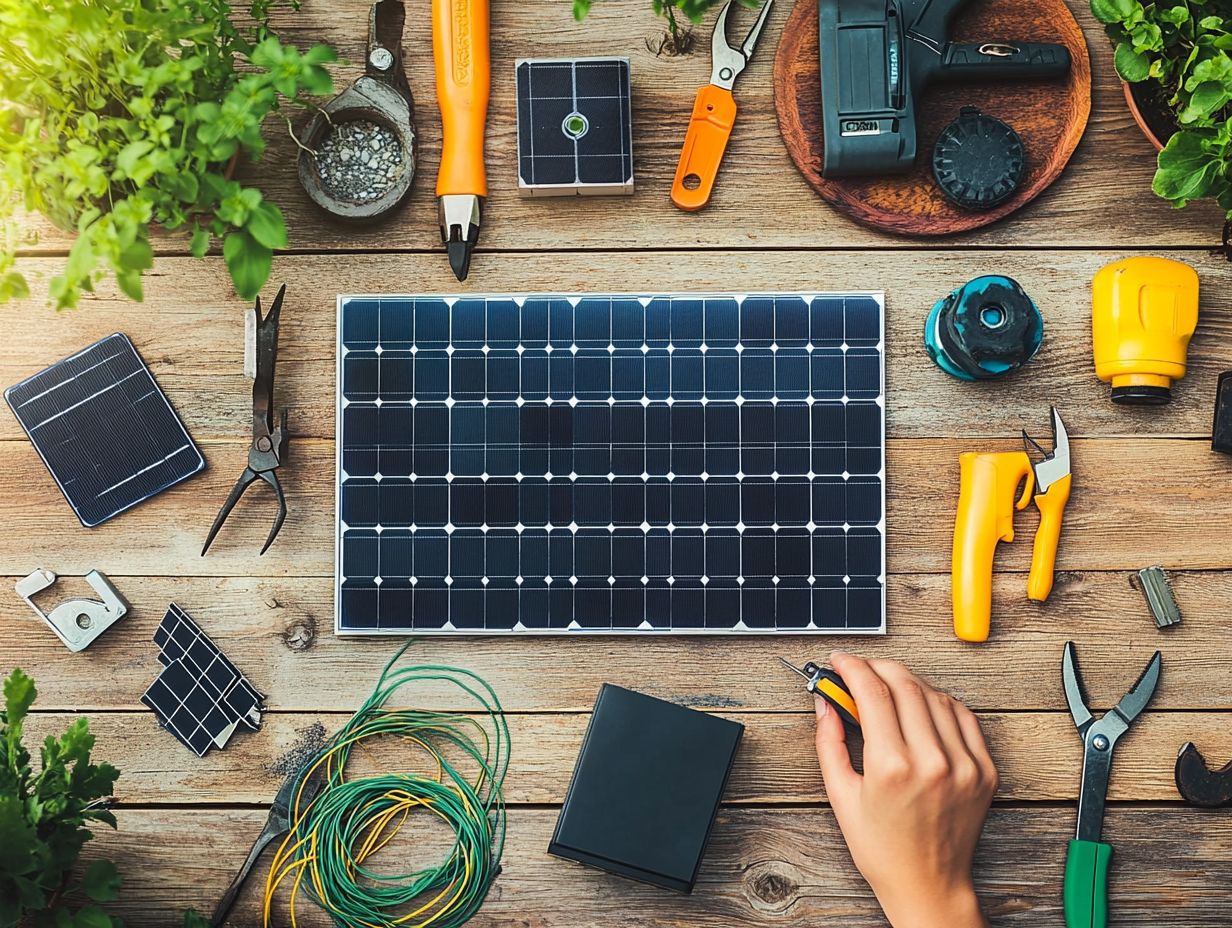
If you want to learn more about alternative energy sources and how they can benefit you, feel free to explore further!
What materials do I need to build my own solar-powered battery charger?
To build your solar-powered battery charger, you need a solar panel, rechargeable batteries, and a charge controller. You’ll also need wires and a battery enclosure.
For a complete setup, consider having a soldering iron, blocking diode, heat shrink tubing, and a voltmeter. You can find components like the 1N4001 or 1N914 diodes at electronics stores such as Radio Shack.
Do I need any special skills or knowledge to build a solar-powered battery charger?
You don t need advanced skills. Basic knowledge of electronics helps, but anyone can follow instructions to build one.
Many tutorials online guide you step-by-step, making this a fun DIY electronics project.
How long does it take to build a solar-powered battery charger?
The build time varies with your experience and the design’s complexity. With the right materials, you can complete it in just a few hours.
This makes it a perfect weekend project!
Can I use any type of solar panel to build a solar-powered battery charger?
It’s best to use a solar panel designed for battery charging for better efficiency. However, any solar panel with suitable output will work if it’s properly connected.
Using tools like a Leatherman can help with precise connections and adjustments.
How much power can I generate with a solar-powered battery charger?
Power generation depends on the solar panel’s size and sunlight availability. A small panel typically generates around 5 watts.
Larger panels can offer up to 50 watts, enough to charge devices from flashlights to smartphones.
Can I build a solar-powered battery charger for different types of batteries?
Yes! You can build a charger for various batteries like lead-acid, NiCd, and lithium-ion. Just make sure to choose the right charge controller for your battery type.
For instance, NiMh batteries are commonly used in portable devices like solar garden lights.


